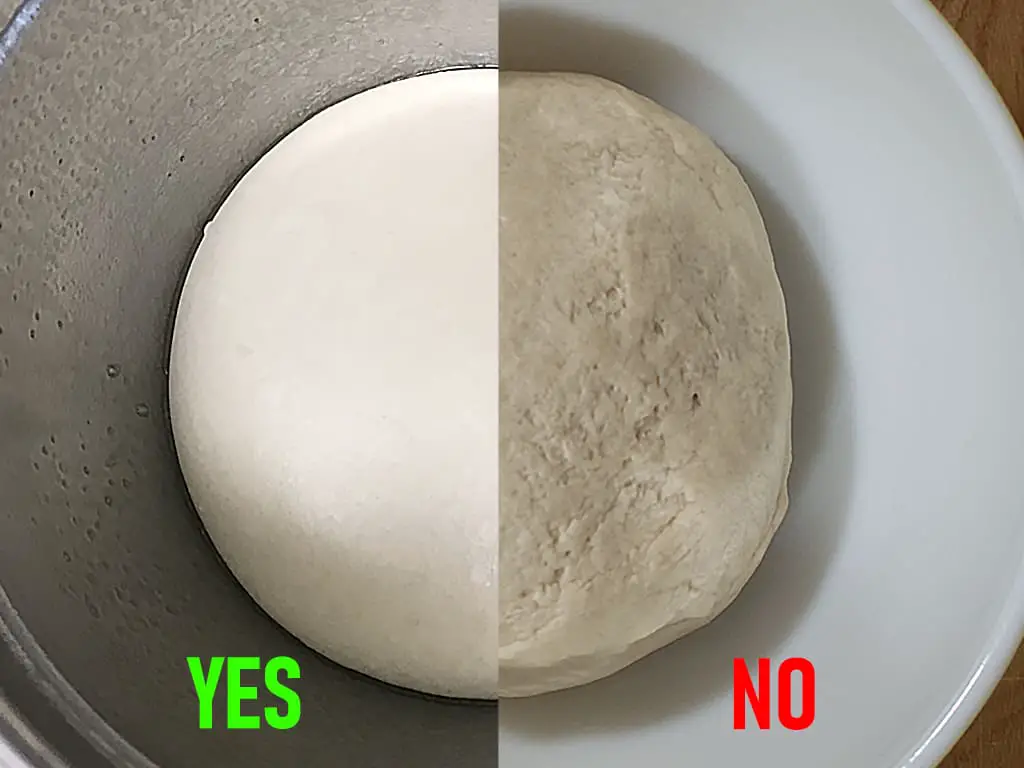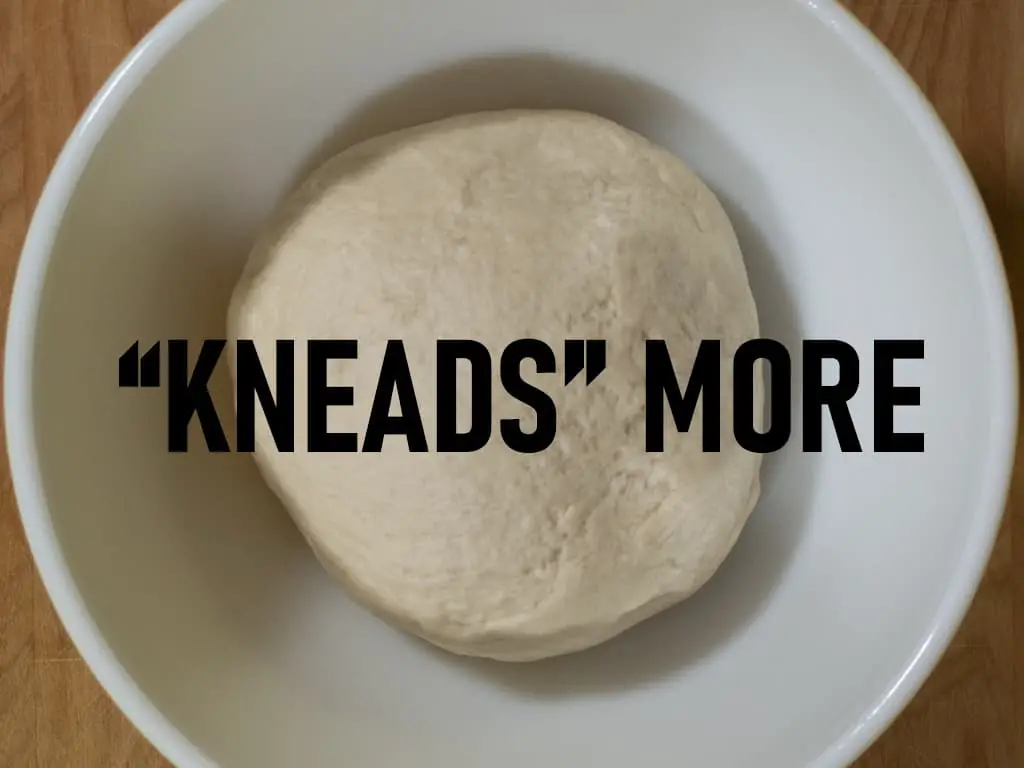I remember being overly nervous about not kneading our dough enough in the early days. I was also quite nervous that I was doing it wrong, somehow. After a while, I started to realize I had carried over a lot of ideas from things I had tried like scones, muffins, and pie crusts which often give more details about how to work the dough or batter. But, I didn’t need to. The kneading process is much simpler than I thought and quite forgiving in most bread recipes.
In fact, many no-knead recipes exist, where there is no need to knead at all. So if you’re not into the kneading thing, find a good no-knead recipe. Oh, wait, what’s that? Why yes, we do have a no-knead recipe. Thanks for asking. You can find it right here: https://kneadrisebake.com/simple-no-knead-crusty-bread/
In all seriousness, if a recipe calls for kneading, you certainly want to do it. However, given the title of this post, if you’re here you’re likely really wondering what will happen if you don’t knead dough enough.
Not kneading dough enough will increase the chances of ending up with a crumbly and dense loaf of bread. Gluten development is what helps bakers avoid both, and kneading dough speeds up gluten development. In many recipes, the faster gluten is developed the better the finished loaf will be.
Why is Fast Gluten so Important?
Gluten is what makes bread dough elastic, or rather, what makes it resist the rise caused by yeast. That sounds counterproductive if we want the dough to rise, I know. But bear with me here.
Think about a balloon. The purpose of a balloon is to be blown up, usually by the gas we take from our lungs and force into it. If we blow enough into it the balloon expands. The resistance is fairly light, but without that resistance, it would never blow up.
To make that point more clearly, let’s look at a contrasting example.
Swap the balloon for a sock. 🙂 Good luck trying to blow that thing up even though it has elastic properties. The elasticity is not tight enough to trap air inside a sock. It simply blows right through.
So let’s put that all together, and hopefully comparing bread dough to a sock didn’t put you off too much.
When you first mix your flour with water, dough is formed and gluten is immediately present. But it is more like a sock at this point. Gas can escape freely. If we want to let it sit for an extended amount of time gluten will eventually get strong enough to trap gas in. But at that point, there is a possibility that the expanding pressure from yeast has already caused tears because gluten starts off weak. Especially true for many commercial yeasted recipes that call for high amounts of yeast. If it isn’t a no-knead recipe it probably has a high amount.
But, if we work the dough by kneading (which is just squishing and stretching and pulling) right out of the gates, then gluten gets a workout. We would be able to eat a lot more bread if our muscle fibers were more like gluten, because it doesn’t take long for them to multiply and get stronger. 10 minutes of kneading is all it takes for your dough to become a gluten, Mr. Universe.
The aim is to counter the power of yeast, with quick gluten development in order to trap enough gas in the dough. Do that will help us have a light and fluffy loaf by the end. We’re also trying to stop gluten from tearing during the rise periods so that our crumb ends up chewy instead of crumbly.
How to Tell What is Enough

You will find that after kneading your dough enough it is smoother, and if you stretch it out a bit it is less likely to tear. It’s a bit odd I know, but consider the sock vs balloon example above once more. If there are gaps in the surface of the dough, it’s not going to blow up in the right way.
To be clear, you’ll still get tasty bread in the end, don’t let this scare you off or feel defeated. Just knead a bit longer next time, and see where that gets you.
PRO TIP: If you feel like you’ve been kneading forever and you don’t see much progress, roll the dough into a ball and let it sit on your work surface uncovered for 2 to 5 minutes. This lets the dough relax and the gluten to develop on its own a bit. Come back to it and knead it a bit more. You’ll likely find that it is smoothing out nicely at this point.
You can also add what is known as the windowpane test. This involves simply stretching a portion of your dough out so that it gets thin enough to see light through it. If it tears before you can see light through it, it needs more time. If it doesn’t tear, you’re likely good to move on.
How Does No-Knead Work
The concept of no-knead bread is just a reversal of what takes place with kneaded recipes. Using less yeast, causes a slower and more consistent release of gas, which gives gluten enough time to develop before being stretched too far.
As I mentioned above, as soon as water is mixed with flour gluten is formed. If given enough time, gluten will continue to form and gain strength. The gentle growth that comes from lower amounts of yeast is enough to work gluten out, without pushing it too hard as to tear the gluten that has developed.
To put this time element in perspective, a long typical kneaded recipe might take 4 to 5 hours to complete. And a short no-knead recipe would take about 6 on a warm day. 🙂
Time is the factor, and bakers adjust energy (yeast) to account for time. More energy from yeast means a faster bread. But it requires more energy on our end to get it ready for that energy punch from yeast. That energy from us is produced via kneading.
Does Kneading Do Other Things?
Kneading also works to warm the internal temperature of dough. This helps speed up yeasts activity. Which is fine, as most recipes account for or intend for this be a part of the process. Which is why kneading enough is important. If we knead only enough to warm the dough, but not to advance gluten strength, then we almost certainly ensure we end up with a crumbly texture.
But you know what tastes good with crumbly textures? Jam! And butter too. So give it a shot and really work that dough. If you’re making a sandwich loaf or the likes, I’m willing to bet over-kneading is not a concern. Go until you can’t go anymore. Or until it’s smooth and passes the windowpane test.
How do I Know I’m Kneading Right?
The goal of kneading is to basically move things around and to stretch and release the dough. There are a host of techniques out there, but typically you’re using the bottom portion of your palm (heel of your hand) to push down on your dough, flattening it and pushing forward. This causes the dough to stretch. Release, fold the dough back onto itself, and repeat that action over and over again.
In short, as long as you don’t stretch the dough out so much that it tears as you are kneading, you’re doing it right. But take care to actually stretch it. If you don’t stretch it at all, it doesn’t quite get the workout it needs.

